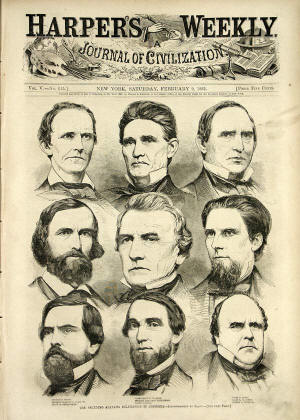 In her book, Loyalty and Loss: Alabama's Unionists in the Civil War and Reconstruction (Baton Rouge: Louisiana State University Press 2004), Margaret M. Storey raises the question how many white unconditional unionists there were in Alabama in 1860-61. Her answer is uncertain and not entirely consistent.
In her book, Loyalty and Loss: Alabama's Unionists in the Civil War and Reconstruction (Baton Rouge: Louisiana State University Press 2004), Margaret M. Storey raises the question how many white unconditional unionists there were in Alabama in 1860-61. Her answer is uncertain and not entirely consistent.She begins by discussing "postwar estimates given by wartime unionists to the Joint Committee on Reconstruction in 1866." These suggest a figure of "from ten to fourteen thousand 'Union votes' out of a statewide voting strength of about eighty thousand -- or about 15 percent." (Actually, 10,000 would be 12.5% and 14,000 would be 17.5%.) However, as Professor Storey herself points out, "[a] tendency to exaggerate numbers was certainly in the interest of" the witnesses. Presumably this means that the estimates were probably high.
After a brief and confusing diversion into whether to include (white) women (me: that's fine, just make sure you compare apples to apples), Professor Storey leaps to the utterly trivial conclusion that "anecdotal evidence has long suggested and the SCC [Southern Claims Commission] claims confirm" that "with rare exception (notably Winston and Walker Counties) unconditional unionists did not represent majorities in their counties before, during or after the war."
Now Winston County is famous for its dissent and Walker County adjoins it, so I assume it's possible that those counties had majorities of unconditional unionists in 1860-61. Unfortunately, there's no footnote or citation for the proposition, so there's no way of knowing. Color me unpersuaded. Perhaps there's further discussion about those particular counties later in the book. As for the remainder of Alabama, should I be impressed by this stunning assertion?
Professor Storey then proceeds to her major conclusion:
With these caveats in mind, it seems safe to say that the number of unconditional unionists in 1861 never outstripped 15 percent of the total adult white population, and was likely closer to 10 percent.
I'm not sure what "caveats" she's referring to, but my bigger problem is that this guess doesn't seem entirely consistent with the earlier discussion. Having previously concluded, or at least strongly suggested, that figures of 12.5% and 17.5% were exaggerated, she now suggests that the figure might be as high as 15%. Even the "closer to 10%" guess sounds like the professor is barely inching below the 12.5% figure that she has labeled suspect, just so that she can say is maintaining consistency. Again, there is no footnote or citation of any kind, so the reader has no way of assessing the guess.
And it is a guess, as the professor, to her credit, immediately confirms:
Such estimates are, however, only informed guesswork, and the statistics used in this study do not come close to incorporating this number of people.






No comments:
Post a Comment